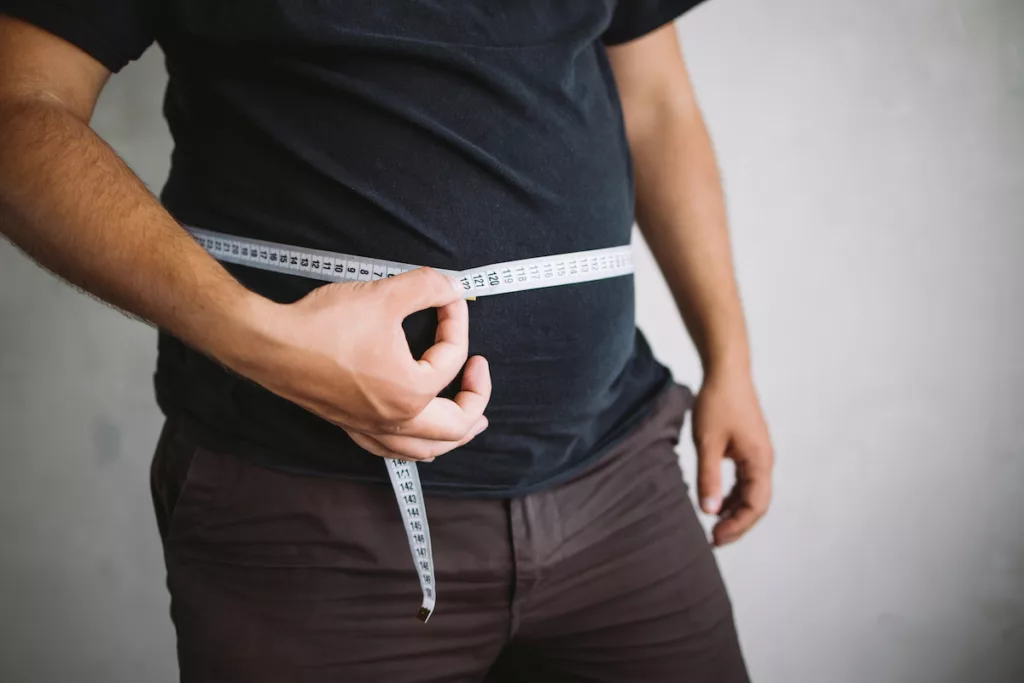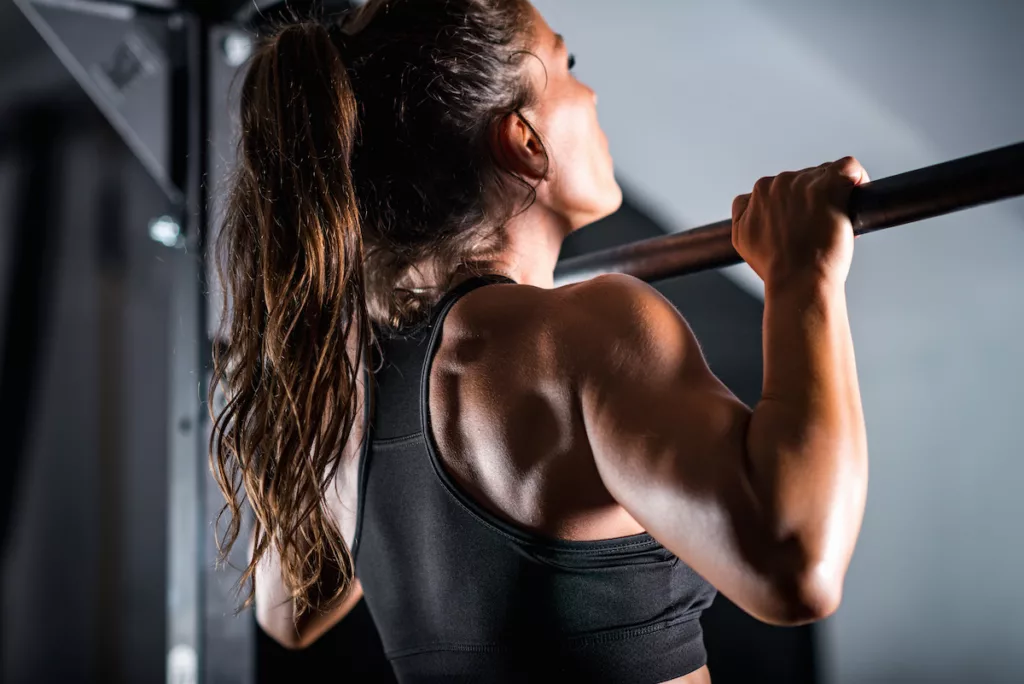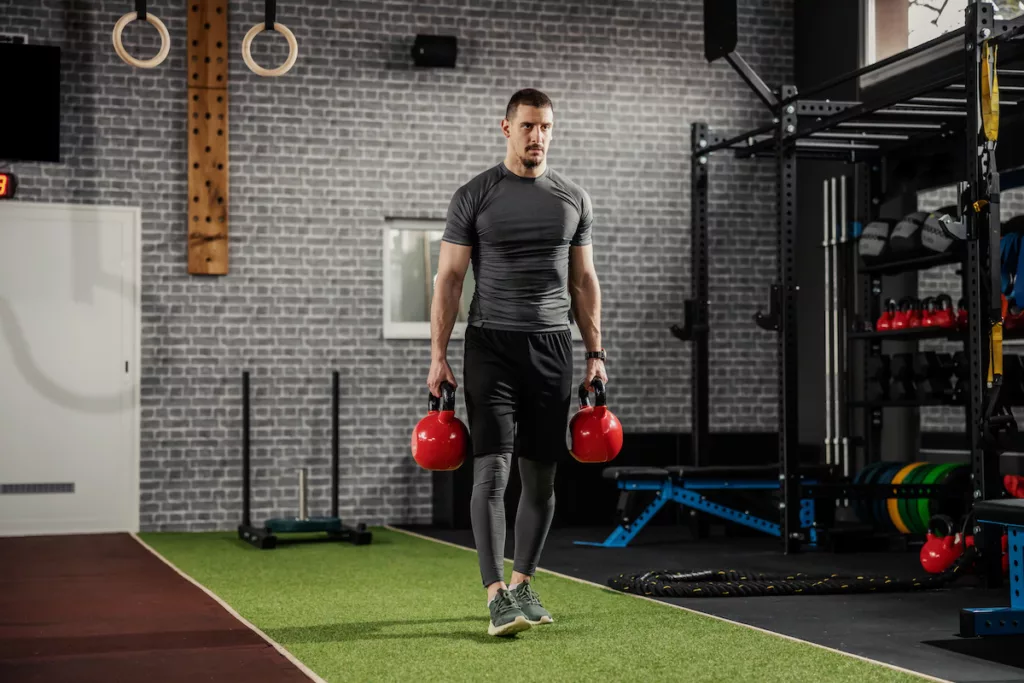Welcome to a journey into the world of how to do a pull-up, a realm often deemed intimidating but incredibly rewarding.
Meet Geni Ligday, a busy mother, devoted wife, and full-time employee hailing from Virginia, USA. Geni is the embodiment of an everyday athlete, juggling myriad responsibilities yet relentless in her pursuit of fitness.
On May 4, 2019, she stunned herself and her friends by executing seven strict pull-ups—a remarkable feat considering she had never done a single one prior to her training.
Here’s the proof:
Pull-ups, often perceived as the pinnacle of upper body strength, elude many fitness enthusiasts. Today, we aim to dispel the enigma surrounding them.
Geni’s transformational journey from zero to seven pull-ups in less than ten weeks is more than an individual triumph; it’s a testament to the effectiveness of dedicated, systematic training.
This blog is about showing you the path to mastering pull-ups and inspiring those of you aspiring to conquer this formidable exercise. With strategic training, determination, and the right guidance, the elusive pull-up is within your grasp.
Get ready to redefine what’s possible for your fitness journey, and the clients you work with, as we delve into how to do a pull-up.
Table of Contents
What Are the Benefits of Doing Pull-Ups?
Pulling is one of the fundamental human movements and for good reason. Nothing expresses this movement more than a good old-fashioned pull-up.
We use pulling movements every single day. Opening doors. Picking something up from the floor. Pulling yourself up onto something, or even climbing or hanging from a ledge.
It’s a fundamental human movement. The stronger you are at this movement, well, the easier life becomes. It’s as simple as that.
It is a compound exercise, meaning you use more than one muscle group, thus allowing you to recruit a maximal amount of muscle fibers to help you put on muscle size and mass. They develop wicked powerful forearms and a vice-like grip.
Building strength through pull-ups transfers directly to other strength and sporting activities. It’s one of the most expressive forms of athleticism. Nothing is quite as empowering as a really good, strong, powerful pull-up, and it makes you look bad-ass!
Oh, and it just happens to be one of the fastest ways to help change your body composition.
How does having a strong, nicely defined back and shoulders sound to you all while helping you define and shape your whole body?
Pretty great, right? That’s the beauty of pull-ups.
How Do I Start My Quest for Pull-Up Success?
As we say about nearly everything we do here at Strength Matters, we need to know the score before we can get into the game. And that means we need to assess and see what your starting point is.
There are a number of key factors that go into helping someone do their first pull-up.
Here are the four most important aspects that you need to address before you can even get into pull-up specifics:
- Body composition
- Basic fundamental strength
- Scapular health
- Postural control
Let’s look at each of these a bit more in depth, as well as the basic assessments you need to do to see where you are right now.
Step 1: Body Composition

Sorry to break it to you, but if your waist is more than half the length of your height, the path to completing your first pull-up will be long and frustrating. The best thing we can do for your health is to help you achieve this number. By doing this, your path to pull-up success will be that much easier.
In all athletic feats and sports, body composition plays a significant role in performance. It’s the same with the pull-up. If you score greater than 0.5 on this test, then we must first address this area. It’s really that important.
The waist-height ratio test is a litmus test to see if weight loss is your first priority in your quest for pull-up success.
For those unfamiliar with this measurement, your waist-to-height ratio is calculated by dividing waist size by height. If your waist measurement is less than half your height, you’re likely not at risk for obesity-related disease.
This test is a reliable source of information to determine if the body is ready and able to cope with the weight and forces needed to do a pull-up.
In the quest to master the pull-up, it’s essential to understand a basic physics principle: the more you weigh, the greater the force required to pull your body upwards against gravity.
In plain terms, carrying extra weight is like attempting pull-ups with a loaded backpack—it simply makes a challenging task even harder.
For those with a waist/height ratio over 0.5, which often signals carrying excess weight, diving straight into pull-ups might not be the most efficient route to success.
Why add more hurdles on the journey towards achieving a pull-up when the task is already demanding?
If the ratio is over 0.5, our first advice would often be to embark on a weight management journey. This is not about exclusion or impossibility; it’s about taking an optimized path.
By reducing excess weight, you effectively lighten the ‘backpack’ you’re pulling up, making the pull-up more achievable and less strenuous.
Instead of immediately targeting full pull-ups, we’d recommend starting with modified versions, like assisted pull-ups or other strength building exercises.
This approach promotes steady progression towards unassisted pull-ups, while also accelerating the process by shedding the extra weight that might have been slowing you down.
Step 2: Building Foundational Strength
The journey to successfully performing pull-ups begins with a foundational structure of strength, much like the construction of a skyscraper begins with the establishment of a robust base.
Without this foundation, your efforts in achieving a pull-up can be likened to constructing a high-rise on sand—it may rise temporarily, but ultimately, it’s destined to falter.
Pull-ups demand a significant magnitude of strength, engaging an extensive array of muscles, contrary to the common belief that it only targets a select few in isolation.
The key to unlocking pull-up success lies in unifying the entire body as a consolidated unit. To kickstart a pull-up, your entire physique must embody strength, exhibit tightness, and be interlocked, showcasing the embodiment of solid teamwork.
So, you may ask, what are the basic strength prerequisites required to attempt a pull-up? Here are our foundational strength tests, designed to gauge your readiness for the pull-up challenge:
- Can you maintain a two-minute straight arm plank hold?
- Are you capable of holding a two-minute glute bridge hold (hips elevated)?
- Can you hang from a pull-up bar (overhand grip) for sixty seconds?
If you find yourself answering NO to any of these tests, it’s crucial we tackle these deficiencies head-on. The reason behind each test is not arbitrary:
The straight-arm plank is a cornerstone of core strength and reflects the basic muscular endurance prerequisite for performing a pull-up.
It’s the concrete poured into the ground before the steel structure rises—vital for stability.
The glute bridge test serves as an excellent stability assessment for your pelvis, lumbar spine, core, and gluteal muscles. These are the architectural pillars that will support your ‘skyscraper.’
The bar hang, on the other hand, is the direct test for the grip strength required for a pull-up. It also offers insight into the health of your shoulders, the ‘crane’ that helps hoist you up.
Recognize that often, unstable or painful shoulders might undermine your pull-up endeavors, making these tests not just benchmarks, but also tools to diagnose potential roadblocks.
Building foundational strength is not just about powering toward pull-ups—it’s about laying the groundwork for a robust, capable, and resilient body.
Step 3: Improved Scapular Health
When talking about pull-ups and chin-ups, the conversation naturally pivots toward the topic of scapular stability.
Consider your scapulae or shoulder blades as the silent backstage heroes, setting the stage for your shoulder joints to perform their mobile feats.
Imagine the shoulder joints as dynamic artists, capable of extraordinary movements, but they require a sturdy, reliable stage to showcase their skills.
The scapulae provide this essential platform. This is why the key to shoulder mobility is not just the flexibility of the joints but the stability of the scapulae.
Think of them as your foundational bedrock, providing the structural support for your ‘performance’—the pull-up.

To ensure the health of your scapulae, several tests are available. However, among fit and healthy everyday athletes, like yourself, we have found the flexed arm hang test to be a simple yet effective evaluation of scapular health.
The test itself is straightforward:
- Can you maintain an overhand grip hang from the bar with your chin clearly above the bar itself?
For men, we aim for a hanging time of at least sixty seconds, and for women, the benchmark is forty seconds.
This assessment should be attempted only if you’ve achieved the foundational strength requirements and have met the basic body composition parameters discussed earlier.
You can certainly try the test regardless, but keep in mind that jumping straight into this without the necessary foundation can be akin to entering a boxing ring unprepared—possible, but not advisable.
The flexed arm hang test not only assesses your scapular stability but also evaluates your shoulder endurance and grip strength.
This triumvirate of strength, stability, and endurance forms the crux of successful pull-ups.
Therefore, ensuring the health of your scapulae and your foundational strength is not just a step but a leap towards your goal of mastering pull-ups.
Step 4: Harnessing Postural Control
In the grand symphony of pull-ups, postural control can be likened to the conductor, guiding and ensuring all parts work in harmony to create a smooth, fluid movement.
While steps one and two lay down the foundational strength and scapular health, steps three and four are intertwined, focusing on grip strength and the vital aspect of postural alignment under load.
Here’s how we assess your ability to maintain this alignment:
- The 75% Bodyweight Farmers Carry for 90 Seconds

This test gauges your capacity to uphold postural integrity while under a load. It’s like checking if a bridge not only bears weight but does so without losing its structural alignment.
Think of your postural stabilizers as the hidden scaffolding supporting a beautiful architectural edifice. They don’t often get the attention that the main lifts garner, but without their steadfast endurance, alignment crumbles, proprioception falters, and stability wavers.
We often put the cart before the horse, focusing on lifting the load rather than on correctly maintaining the posture under that load.
However, the ability to safeguard integrity under load is as, if not more, important than the ability to lift the load itself.
Imagine the posture as the chassis of a car, holding the vehicle’s weight and maintaining its shape. It must be strong and resilient, capable of withstanding the loads it’s subjected to during motion.
Similarly, your postural stabilizer endurance should be robust, far surpassing the prime movers, as it’s fundamental to the safe, effective movement of the load.
In essence, achieving postural control is like mastering the art of balance in motion. By nailing this aspect, you’re preparing your body to handle the dynamic requirements of a pull-up, advancing you further on your journey to this elusive fitness goal.
The Training Plan: How We Helped Geni Achieve Pull-Up Success
Now that you know some of the key things we look for prior to helping someone achieve their first pull-up, here’s Geni’s starting point:
- Body Composition: – Check. All in order.
- Foundational Strength: – Check. All in order.
- Scapular Health: – Uh oh. Flexed-arm hang only 12 seconds.
- Postural Control: – Check. All in order.
This allowed us to pinpoint the one area that we needed to work on—the health of her shoulders and muscular endurance.
Geni was already strong enough in all the vital areas, but she needed improved scapular stability, mobility, and muscular endurance.
Geni: Phase One Training
Stage one was about re-building and working on her scapular health with the bigger picture leading to pull-ups once we had established the basics.
She was prescribed a lot of scapular push-ups and forearm scapular rolls.
In fact, she had one entire workout once a week dedicated to rowing and scapular work.
Here’s what she did on that day:
Row + Scap Workout
- 10 sets. 500m row @2:20 pace (Feet out the straps). 1 Minute Rest. Repeat.
- During the one-minute rest perform:
- 10 scapular push-ups
- 5/5 scapular plank rolls
On other days, we’d start focusing on scapular health with isometric and core strength to integrate everything. The goal was to get her new mobile shoulders to explore these new ranges of strength.
Here’s what this second day looked like:
Activation Circuit:
- Three Sets. 1 minute between rounds.
- A1) Scap circles, legs resting, 5 each way
- A2) Scap circles plank, 5 each way
- A3) Hanging knee raise, 5 reps with a 1 second pause at the top
Isometric Circuit:
- Four Sets. 1 minute between rounds.
- A1) Flexed arm hang, as long as possible
- A2) One arm/one leg plank hold, both sides, as long as possible
- A3) Push-ups, or inclined push-ups, 5-10 reps
As you can see, we’re priming the scapula and then integrating them with isometric work in the main circuit. This was the key for Geni. Muscular endurance, scapular health, isometric work, and a strong core, all working together.
This was a primer for Geni’s main pull-up program. We worked on the foundation first before we went anywhere near doing actual pull-ups.
She went from ZERO to seven pull-ups in ten weeks because she spent a solid EIGHT weeks doing the prep work necessary.
During this time, Geni’s flexed arm hang went from 12 seconds to 1 minute 10 seconds.
The power of getting the basics right.
Geni: Phase Two Training
Stage two of the plan was to work towards an actual pull-up. Now that Geni was able to hold a flexed arm hang for well over the 40-second mark, it was time to focus on the strength needed to perform a pull-up.
Twice a week, while working on her deadlift (which went from 235lbs to 270lbs, but that’s another story at 127lbs bodyweight), we focused on volume building and working the negative of the pull-up.
She could successfully hold a flexed arm hang for over a minute, but we needed to work on the negative aspect of the pull-up, another often forgotten tip to winning the pull-up game.
Here’s what she did twice a week during this time:
Negative Pull-Up Training
- 10 Minutes. 10 Sets. 1 Rep. EMOM.
- @31A0 Tempo (3 Sec Descent – learn more about tempo training here)
- Immediately at the end of 10 min:
- 1 x max flexed arm hang
As the weeks went on, we manipulated the time of descent. What started at 3 seconds became 10 seconds over four weeks, increasing by two seconds each time. As the weeks went by,
Geni began to see that the more she did this, the more she was initiating the flexed arm hang by pulling herself up over the bar.
It was at this point that we changed the workouts from negative pull-ups to actual pull-ups.
Pull-Up Training
- 10 Minutes. 10 Sets. 1 Rep. EMOM.
- @51X0 Tempo (5 Sec Descent – learn more about tempo training here)
- Immediately at the end of 10 min:
- 1 x max flexed arm hang
She could now effortlessly do one pull-up—on the minute, EVERY minute—followed by a flexed arm hang for over 30 seconds at the finish.
We then extended the time out to 12 minutes, and then eventually 20 full minutes!
Here’s the important factor to remember. NEVER ONCE did Geni do more than one pull-up in a row. She followed our principle of “growth comes in comfort and flirt with failure.”
And when she did attempt it, she banged out seven in a row. And not just seven pull-ups. Seven perfect pull-ups with exceptional technique and postural control.
Here’s the video again if you need reminding:
Final Thoughts
The pull-up is a compelling testament to one’s athleticism. It’s a tantalizing goal that often sits atop many fitness wishlists, yet the journey to conquer it is riddled with complexities and misconceptions.
Pull-ups demand not just brute strength, but a delicate tapestry of shoulder health, core control, and postural stability.
Our guide unravels the intricate layers that build up to this pinnacle of physical prowess. It spotlights the essential prerequisites you need to solidify before even daring to dangle from that bar, aiming for your first pull-up.
Rest assured, drawing from our professional experience, this approach is akin to paving the fastest, most efficient highway towards your pull-up success.
Let Geni, the real-life dynamo from our case study, be your beacon of inspiration. As a busy mom juggling four kids and a demanding full-time job, she still managed to scale the pull-up mountain.
She stands as a living testament that age, responsibilities, and life’s chaotic schedule are not roadblocks but mere speed bumps on this journey.
Mastering the pull-up isn’t just about the destination—it’s about knowing where to start, embracing the process, and honoring each stride forward, no matter how small it might seem.
So, here’s to you, standing at the precipice of your pull-up journey, armed with the right knowledge, fueled by determination.
We raise a toast to your upcoming pull-up triumphs. Let the journey begin!
Geni’s Story: In Her Own Words
FAQ
How to Do a Pull-Up for Beginners?
For beginners, doing a pull-up involves a step-by-step process. Start with foundational strength exercises such as planks, glute bridges, and bar hangs. Work on your scapular health with exercises like scapular push-ups and forearm scapular rolls. Then, progress to isometric exercises and postural control tasks like the Farmer’s Carry. Gradually introduce negative pull-ups and finally full pull-ups, always ensuring good technique and postural control.
How Do I Build Strength for Pull-Ups?
Building strength for pull-ups involves improving foundational strength, scapular health, and postural control. Start with basic strength exercises such as planks, glute bridges, and bar hangs. Once you can pass these foundational strength tests, progress to scapular exercises and then to isometric and postural control exercises. Introduce negative pull-ups before finally progressing to full pull-ups. This process ensures that you build strength in a safe and structured manner.
Can Everyone Do a Pull-Up?
With the right training and dedication, nearly everyone can do a pull-up. It’s essential to understand that achieving a pull-up requires time, patience, and a systematic approach to build the necessary strength, scapular stability, and postural control. It’s not just about the pull-up motion itself but about strengthening your entire body to handle the load.
Why Can’t I Do Pull-Ups?
Struggling with pull-ups often comes down to lack of strength, scapular instability, or poor postural control. Building foundational strength, improving scapular health, and ensuring good postural control are vital. Neglecting any of these aspects can hinder your ability to do a pull-up. It’s also important to remember that achieving a pull-up is a gradual process, and consistent, systematic training is key.

